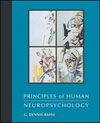In this chapter we continue to pursue a question to which we have already devoted considerable time: How do we see the visual world as we do? We have seen that light impinging on the retina activates rods and cones and sets in motion a complex pattern of neuronal activity that, through the mediation of bipolar, amacrine, and horizontal cells, is highly complex even before it leaves the retina. The optic nerve conducts this pattern to a number of structures, the most important being the lateral geniculate nucleus of the thalamus, and from there projects information to the cerebral cortex. We have also seen functional specialization within areas of cortex devoted to vision, such that certain areas are specialized for the processing of various subcomponents of vision, including color, form, and motion, and that these areas have distinct and specific microarchitectures. In addition, we have seen that we are beginning to understand the nature of the anatomical interconnections between these specialized areas. We are, however, still left with the question of how we see the world: How, within the darkness of the skull, does the activity of the brain generate a meaningful representation of the visual world? It will come as no surprise that we are far from a complete answer to these questions. Nevertheless, the study of patients with impaired visual recognition due to brain lesions, together with the physiological and anatomical findings emerging from animal studies that we have already discussed, provides some insight into how we construct visual representations. Disorders of vision that are not due to disruption of elementary visual function (or the severity of which is incommensurate with relatively mild disorders of elementary function that may be present) and that are not due to generalized intellectual impairment are termed visual agnosia. We begin our discussion with an account of a case of visual agnosia described by Oliver Sacks. The striking nature of this patient's pattern of impaired and preserved functions dramatically depicts what can happen when higher visual functioning is disrupted in humans. We will then briefly review some of the early attempts to understand disorders of higher vision and their implication for an understanding of normal visual recognition. These disorders have traditionally been divided into three categories: partial cortical blindness, apperceptive agnosia, and associative agnosia, which together suggest a hierarchy of sequential processing stages mediating object recognition. According to this hierarchical account, visual recognition can be divided into three general phases: (a) the processing of relatively elementary components of vision (such as acuity, simple shape, and color), (b) the integration and organization of these components to yield percepts, and (c) the assignment of meaning to these percepts. From this point of view, partial cortical blindness, apperceptive agnosia, and associative agnosia are seen as breakdowns in each of these three phases, respectively. We will see that this sequential-hierarchical model accounts for a good deal of data that has emerged from the study of patients with higher visual disorders. Nevertheless, data also exist that are inconsistent with this model. They suggest that the division of object recognition into discrete sequential stages, particularly the separation of percept formation and meaning assignment, may be a serious oversimplification—that the seemingly obvious distinction between seeing and knowing may not be a useful framework for understanding how we represent the visual world. But we are getting ahead of our story; let's begin with a look at a patient with visual agnosia. |



 2002 McGraw-Hill Higher Education
2002 McGraw-Hill Higher Education